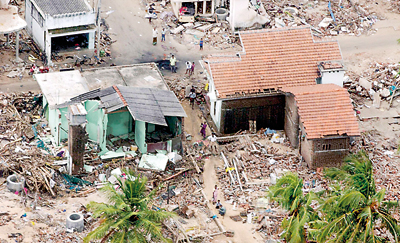Remembering the poignant tales of Tsunami survivors
View(s):By D.C. Ranatunga
At this time every year since 2004, we are reminded of the tragedy which hit Sri Lanka on Boxing Day – the tsunami in which 32,000 people died, another 6,000 went missing and at least 550,000 were made homeless.
One of the most poignant books I read on the event was ‘Tsunami: 7 Hours That Shook the World’ by Satinder Bindra, CNN’s New Delhi Bureau chief. Bindra calls his book “a story about two waves. The first, a killer; the second, a wave of compassion, which became the largest-ever relief operation launched in the world.” His objective was “to introduce you to dozens of warm, generous and selfless people who truly made a difference to their communities.”
He talks about how he was motivated to write the book. He refers to a nine-year-old Tharesh Liyanage (“one of my favourite characters”) from Galle who was reading a book when the tsunami roared through his home. The force of the water had hurled Tharesh onto the street. His mother fainted and died in front of his eyes. But Tharesh clung onto life.

And hope. A few days later Bindra ran into Tharesh in the Galle hospital trying to identify his dead mother through pictures taken by the forensic pathologist Dr. Rohan Rohanpura. “I couldn’t imagine a more difficult task for anyone, leave alone a nine-year-old,” he writes. “But Tharesh presented a picture of calm. He identified his mother with a quick nod of his head and later talked about his plans to honour her memory by working hard at school and becoming a scientist.” Bindra wanted to share Tharesh’s story and describe the resilience of such survivors and pay tribute to their courage and humanity.
At the time of the tsunami, Bindra was holidaying on the beach in Colombo with his family. He watched the first waves roll in, flood the road and come right up to the wall of the hotel they were staying in. They managed to scramble to high land and were safe. The man on holiday was soon busy at work. It’s his observations on the event and what followed that fill the near 300 pages of the Vijitha Yapa publication released in April 2005. He describes what he saw, in typical journalistic style making it very informative as well as emotional. His stress is on the human aspect of the tragedy.
Bindra presents the Peraliya train tragedy through a survivor’s harrowing tale – how he and his daughter escaped while his wife and brother-in-law went missing. It was a bitter struggle having to fight through not one but several huge waves. Having survived the first, the family was rushing for safety. “A 15-foot wave flowed in towards me and I shouted to my wife. She wasn’t there. When I turned back I collided with something and fell down. Both me and my daughter were dragged down by the water and we came up again. Close to us there were some people on the roof of a house.
I tried to hand over my child to those people. But my daughter refused and clung onto my body. Instantly, another big wave came in. Both of us were flung away and got stuck between two houses. At that moment, I found a small papaya tree close by and grabbed it. The waves were so huge that they were flowing over my head several times,” Chandrasiri Liyanage told Bindra. They were lucky to hold on to a wire that some people threw at them. Seconds later, the papaya tree was consumed by the waves. The two of them escaped. He began looking for his wife and brother-in-law in relief camps and hospitals the next day but did not find them.
In the East, Bindra describes how English teacher Sree Skandarajah was looking for his neighbour’s four-month-old baby. The search had left him tired, thirsty and hungry. So, when he glanced upon a carton of cookies amidst a pile of rubble, he quickened his pace. As he got closer, he heard some scratching noises coming from the carton.
‘I thought it was a chicken’, Sree told Bindra. ‘But when I bent down I thought I saw god. I saw a crying baby and I thought god had come down to earth in the form of a baby’. The baby, covered in garbage, appeared to be in perfectly good health except for some bruises. ‘I thought it was a miracle,’ he declared, and promptly asked a volunteer to rush the baby to the Kalmunai hospital.
The story does not end there. ‘Baby 81’ was the subject of a long battle in court and heavy focus by the local and international media until the parents were given custody.
Bindra in the concluding paragraph in his preface says: “I truly hope that the stories in this book – of human compassion and fortitude of the heroism of children and the inherent goodness of people – will rekindle hope and give reason to an existence that is threatened by forces that we don’t really understand.”
I wish we could trace young Tharesh and the little boy from Kalmunai who are now nine years older and see how they are faring in life.
Follow @timesonlinelk
comments powered by Disqus


















